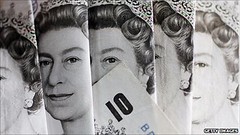
PREV ARTICLE
NEXT ARTICLE
FULL ISSUE
PREV FULL ISSUE
HOW MUCH FORGED MONEY IS IN CIRCULATION IN THE UK?
This BBC News article discusses the circulation of counterfeits in the U.K.
-Editor
It is not difficult to see the watermark, hologram and metal thread inside banknotes. But visit De La Rue, the company that prints banknotes for the UK and 150 other countries and you will discover a wealth of other, hidden security features. Whereas most graphic print uses just one printing process, sterling banknotes are made with three. Run your fingernail across the number ten in the top right corner, and you'll feel how bumpy the surface is. The tactile intaglio print deposits the ink in recesses in the paper surface also giving the banknote its crisp, shiny quality. "It's a high pressure printing process so where there's no type you get a smoothing of the paper, which also means the note doesn't accept dirt so easily," says Paul Howland, head of paper science at De La Rue. Behind Darwin's head, the pastel blues, greens and oranges are not made up of dots of colour, like most graphics, but instead are made up of tiny lines as a result of the offset printing technique used. There is also microprint hidden inside the images. A magnifying glass will reveal the word "ten" printed inside the Queen's pearls. But at London's Church Street market, stallholders still have to keep their eyes peeled for fakes. "You get spates of them, every now and again," a fruit and veg seller said. "Everyone will get one or two." Skimming the top edge of the intaglio print will often tell stallholders whether the note is a fake, but some even pass this test: "If you saw the last lot we had, they were perfect. You couldn't tell by looking at them," he said. In 2009, Bank of England figures revealed 566,000 counterfeit notes in the UK. Of these, 95% were twenty pound notes.
To read the complete article, see:
How much forged money is in circulation in the UK?
(www.bbc.co.uk/news/business-12578952)
The Numismatic Bibliomania Society is a non-profit organization promoting numismatic literature. See our web site at coinbooks.org. To submit items for publication in The E-Sylum, write to the Editor at this address: whomren@gmail.com To subscribe go to: https://my.binhost.com/lists/listinfo/esylum All Rights Reserved. NBS Home Page Contact the NBS webmaster 
|
